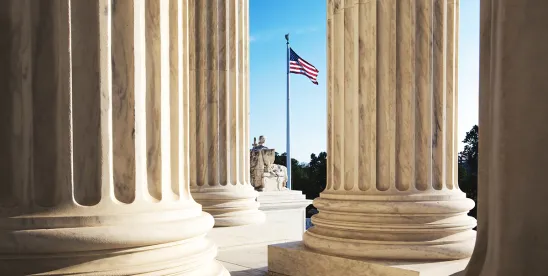The U.S. Supreme Court issued a decision directing district courts to use the traditional four-part test when evaluating whether a preliminary injunction should issue at the request of the National Labor Relations Board pending litigation of a complaint under the National Labor Relations Act. No. 23-367 (June 13, 2024).
The decision settles the split among the federal circuit courts over the standard that should be applied when the Board files a motion for a “10(j)” injunction, named for the section of the Act that authorizes the Board to seek injunctive relief. Circuit courts were split on which test should apply: the traditional four-part test, a more lenient two-part test, or a hybrid of the two.
The Court’s decision raises the bar for the Board, requiring it to meet each prong of the four-part test for a court to grant an injunction. In particular, it will be more difficult for the Board to establish it is “likely to succeed on the merits,” as opposed to the more lenient standard espoused by the Board that “there is reasonable cause to believe that unfair labor practices have occurred.”
The Court vacated and remanded the case to the U.S. Court of Appeals for the Sixth Circuit to reevaluate the merits of the injunction request under the four-part test.
10(j) Injunctions
Section 10(j) of the Act allows the Board to seek preliminary injunctions before federal district courts against both employers and unions to stop alleged unfair labor practices during the pendency of the Board’s administrative processing of an unfair labor practice charge. Section 10(j) authorizes a district court “to grant to the Board such temporary relief … as it deems just and proper.”
The requests are rare; the Board has sought only 20 such injunctions since 2023, according to the Board’s website. Nonetheless, the standard a court will use in evaluating the injunction request has been determinative of whether the relief was granted.
Prior Standards
The U.S. Court of Appeals for the Sixth Circuit, as in this case, used a two-part test to assess whether the Board was entitled to an injunction. The two-part test examined whether “there is reasonable cause to believe that unfair labor practices have occurred,” and “whether injunctive relief is ‘just and proper.’” McKinney v. Ozburn-Hessey Logistics, LLC, 875 F.3d 333 (2017). The Supreme Court noted in its latest decision that the Board could establish reasonable cause “by simply showing that its ‘legal theory [was] substantial and not frivolous.’”
Conversely, other courts, such as the U.S. Court of Appeals for the Seventh and Eighth Circuits applied the four-part test used for preliminary injunctions in traditional litigation settings set forth in Winter v. Natural Resources Defense Council, 555 U.S. 7 (2008). Under the Winter framework, a party seeking injunctive relief must “make a clear showing” that:
- He is likely to succeed on the merits;
- He is likely to suffer irreparable harm in the absence of preliminary relief;
- The balance of equities tips in his favor; and
- An injunction is in the public interest.
New Standard for Labor Board
In holding that the four-part test applies to 10(j) injunction requests by the Board, the Court declined to allow Section 10(j) language “to supplant the traditional equitable principles governing injunctions.” Rather, courts should apply standard principles involved in granting injunctive relief, not 10(j)’s “discretion-inviting directive.”
The Court explained that the reasonable-cause standard in the two-part test “goes far beyond simply fine tuning the traditional criteria to the Section 10(j) context—it substantively lowers the bar for securing a preliminary injunction by requiring courts to yield to the Board’s preliminary view of the facts, law, and equities.” It noted there is a substantial difference between the “likely”-to-succeed-on-the-merits standard versus a finding that the charge was “substantial and not frivolous.” Under the “less exacting” standard, courts could evaluate injunction requests giving significant deference to the Board under even a “minimally plausible legal theory” without assessing conflicting facts or questions of law.
Accordingly, the Board must satisfy the traditional standard that requires it to make a clear showing it is likely to succeed on the merits of the claim under a valid theory of liability.
The Court’s decision to standardize 10(j) injunction requests not only raises the Board’s burden of proof, but it creates more consistency across district courts at a time employers increasingly face injunction requests by an activist Board general counsel.






 />i
/>i

